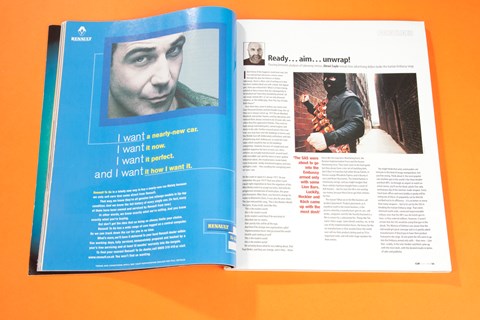► ‘Ready… aim…. unwrap!’
► Classic Alexei Sayle column from 1999
► The Jam, the SAS and the Nissan Bluebird
I don’t know if this happens round your way, but I’ve noticed that whenever a menu comes through the door for Chinese or Indian takeaways, there is often a bit of writing on it that has been crudely inked-out with a black, felt-tipped pen. Have you noticed this? What is it that is being printed on these menus that has subsequently to be blacked out? Have they mistakenly printed: ‘all our soups contain dirt’ or ‘we use only diseased chickens’; or ‘Die infidel pigs, from The Star of India Balti House’?
And when they come to deliver you Sweet and Sour Diseased Chicken and Dirt Noodle Soup, the car they use is always a beat-up, 1977 Nissan Bluebird. Bluebirds and similar Toyotas used by takeaways and minicab firms always seemed to be 20 years old, even when they first appeared in Britain. They seem to have always had faded paint, ruined engines and dents in the side. Further research proves this to be true: you may have seen the buildings in Greece and the Middle East left deliberately unfinished, with bits of reinforcing steel sticking out, to avoid the state taxes which would be due on the building’s completion. Similarly, because of complicated and punitive Japanese tax laws on new cars, these vehicles are actually manufactured ‘second-hand’: with incredible care and the latest in laser-guided industrial robots, the manufacturers create holed, rusty bodywork, smoky, knackered engines and torn, springless seats thus avoiding the swingeing taxes on ‘new’ cars.
On the roads in Japan it is always 1977. Do you remember the year 1977? That was when I used evil rights legislation to force the organisers of the Miss World contest to accept my entry. And with the progressive introduction of metrication, the great jazz trumpeter, Miles Davis, was forced to change his name to Kilometres Davis. It was also the year when The Jam released the song: ‘This is the Modern World: The lyrics, if you recall, went like this;
This is the modern world,
this is the modern world,
In the modern world there’ll be new kinds of
chocolate-bar ice creams,
Anti-gravity hates will be all the rage,
And there’ll be strange new organisations called
‘implementation forces’ that go around the world’s
trouble spots looking at stuff.
This is the modern world,
this is the modern world.
He certainly knew what he was talking about, that Paul Weller, and they are strange, aren’t they – those forces like the Iraqi Arms Monitoring Force, the Bosnian Implementation Force and the Kosovo Monitoring Force. They never seem to do much good, but they always have a nice set of matching 4x4s, don’t they? In Iraq they had white Nissan Patrols, in Kosovo orange Mitsubishi Pajeros and in Bosnia it was Land Rover Discoveries. The United Nations is notoriously corrupt, and you might imagine that these vehicles had been bought from a cousin of Kofi Annan’s — but for once the UN is not wasting our money, because these forces get their vehicles for free.
The reason? What we in the film business call ‘product placement.’ Product placement, as it manifests itself in the movie business, is the process whereby a manufacturer gets its cars, soft drinks, computers and the like heavily featured in a film in return for a substantial fee. Things like The Saint’s Volvo coupe, James Bond’s watches, etc. In the case of the implementation forces, the bonus for the car manufacturers is that security forces the world over will see their products being used on TV in important work, and will order huge numbers for their armies.
You might think that army commanders are immune to this kind of image manipulation, but you’d be wrong. Think about it: the most popular sub-machine gun in the world is the 9mm Heckler and Koch MPS. Go through an airport or watch an action movie, you’ll see the black, plastic fore-grip and banana clip of this German-made weapon. Every Swat team officer and every baddy or goody will be toting one of these. Its popularity can be directly ascribed not to its efficiency — it is no better or worse than many weapons — but to its use by the SAS in breaking the Iranian Embassy siege. That event, televised world-wide, convinced impressionable military men that the MP5 was the butch gun to have, so they ordered millions. However, it wasn’t certain that the SAS would be using that gun in the attack. The Ministry of Defence was aware that the raid would get great coverage and so it quietly asked manufacturers if they’d pay to have their product featured in the siege. At one point the SAS were to go into the Embassy armed only with — then new — Lion Bars. Luckily, in the end, Heckler and Koch came up with the most dosh, with the desired results in terms of sales and publicity.
